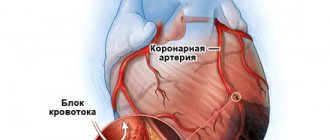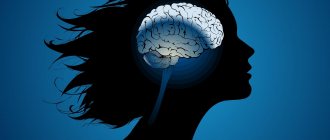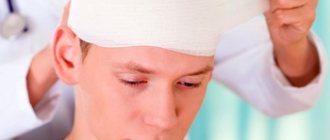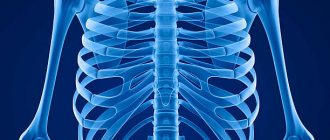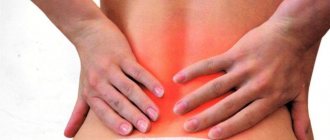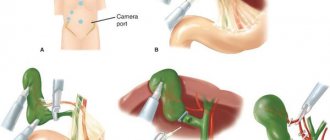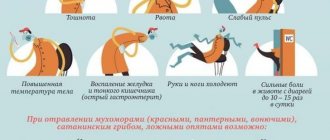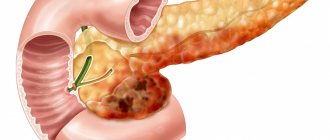What is hepatic colic?
The content of the article
Hepatic colic, also known as biliary colic, is a condition characterized by severe abdominal pain in the right hypochondrium or middle epigastrium (upper abdomen).
Hepatic colic usually occurs when you eat heavy or fatty foods. The condition is very unpleasant, the pain can extend to the back, and associated symptoms may include gas, heartburn or vomiting.
Heartburn
The pain of hepatic colic comes on suddenly and disappears slowly, sometimes lasting up to several hours. Hepatic colic is not a disease in itself, but may indicate more serious diseases, such as the gallbladder. Ignoring the problem can lead to serious complications.
Treatment of postcholicystectomy syndrome
Since PCES is not an independent disease, treatment of the syndrome is always determined by its causes. Not knowing how to properly treat postcholicystectomy syndrome can only aggravate the condition and increase unpleasant symptoms.
The principles of treatment for PCES include two key points:
- collection of anamnesis data - the doctor carefully studies old medical reports and records, paying close attention to preoperative diagnostics and the protocol of the operation;
- eliminating the causes of the syndrome;
- prevention and treatment of suspected complications.
Treatment is mainly based on:
- diet therapy;
- drug treatment;
- surgery (according to indications)7.
Together with comprehensive treatment, these measures can reduce the severity of symptoms of PCES8.
Hepatic (biliary) colic - causes
Eating large amounts of foods containing animal fats is associated with high cholesterol levels. This, in turn, causes the formation of deposits that accumulate in the gallbladder and interfere with its function. The function of the gallbladder is to push out the bile needed to digest food - if something interferes with the contraction of the gallbladder, it must contract more intensely. This is the direct cause of hepatic colic and the severe pain associated with it.
Colic occurs when accumulated bile has difficulty moving due to deposits in the gallbladder or bile ducts.
First aid to a patient
Poor nutrition as a cause of renal colic
If there is a person nearby who has an attack of hepatic colic, there is no need to be afraid. It is necessary to gather courage and provide first aid to the person, which will consist of the following:
- First of all, you need to try to calm the person down, since anxiety and fear provoke pain even more.
- Call an ambulance and tell them what symptoms the patient has
After the person has calmed down, he must be laid on his right side, after placing a heating pad under him. Heat is required in order to relieve muscle spasm, at least a little, which in most cases provokes severe pain. True, you need to be careful with heat, since it can only be used if a person does not have gallstones.
If an attack occurs for the first time, and the person himself does not know its cause, then it is better to simply lay him on his right side and not use heat, as it can cause harm.
If possible, give the person pain medication. It should be noted that it is best to administer the drug intramuscularly for it to have a positive effect. If there are no necessary medications nearby and there is no person who can give an injection, then it is better not to give the patient any pills. The tablets will definitely not have the desired effect, since, combined with nausea and frequent vomiting, they simply will not reach the stomach and will not dissolve. After this, you need to wait for the ambulance to arrive and distract the person, although this will not be very easy.
Cholelithiasis
Gallstones are nothing but the presence of deposits in the gallbladder or bile ducts. Gallstones are more likely to affect women, obese people, older adults, diabetics, and patients taking oral contraceptives or other estrogen medications.
Gallstones
Gallstones can occur at the same time as duct stones because deposits in the gallbladder are tiny and can travel with bile into the bile ducts, blocking their narrow lumen. In addition to hepatic colic, jaundice indicates urolithiasis, which is additionally accompanied by a change in the color of the stool and unpleasant itching of the skin.
Main symptoms of liver diseases
A variety of symptoms, many of which have a rather characteristic manifestation, will help the doctor to promptly identify the problem and prescribe treatment. However, there remains a danger that some diseases in the early stages are practically asymptomatic. To eliminate the risk of developing the disease and diagnose the liver in a timely manner, gastroenterologists and hepatologists recommend paying attention to some points.
Liver dysfunction can manifest as one symptom or a combination of them, which depends on the specific disease and the presence of associated complications.
Pain and discomfort
Painful sensations are usually concentrated in the right hypochondrium. In some cases, they can radiate to the area between the shoulder blades, separately to the right shoulder blade. Pathology can be assessed based on the type and intensity of pain. For example, minor discomfort with aching pain, which complements the feeling of heaviness, may indicate the presence of an inflammatory process, including that caused by toxins. It is very difficult for the patient to clearly show the place where the pain is concentrated.
Intense and severe pain in the hypochondrium is characteristic of severe inflammation, including purulent inflammation. It is present in cases of stones in the bile ducts, liver injuries. Painful sensations are also typical for hepatic colic, which is caused by the movement of stones in the bile ducts.
There are pathologies that do not manifest themselves as unpleasant sensations. These are indolent processes, such as hepatitis C or cirrhosis of the liver. The patient does not notice them for a long time, which is why liver diagnosis and treatment may be delayed. Often these diseases are detected already in the later stages of development.
Vomiting and nausea
Feelings of nausea and vomiting are quite common with gastrointestinal diseases. If the problem affects the liver, these symptoms will be much more severe.
With the appearance of nausea, problems with appetite begin - it becomes dull or disappears completely. There is an aversion to specific foods, usually high in fat. In some cases, an attack of nausea ends with vomiting, after which relief occurs for a while. An admixture of bile in vomit indicates liver problems.
Manifestation of symptoms in the oral cavity
A characteristic symptom is the appearance of a yellow coating on the tongue. The intensity and color depend on the disease. For example, slight jaundice closer to the tip of the tongue may indicate an early stage of hepatitis. The appearance of a yellow-green coating is characteristic of serious pathologies of the gastrointestinal tract, biliary tract or liver. Stagnation of bile manifests itself in the form of a rich yellow coating. At these stages, tests may be prescribed to check the gastrointestinal tract.
An unpleasant bitterness may also be present. It occurs when bile enters the esophagus. The presence of a pronounced taste may be a symptom of viral hepatitis, liver tumor or cirrhosis, gastrointestinal tract disease or gall bladder. Sometimes bitterness is caused by severe stress and taking certain medications. To accurately determine the disease, doctors prescribe a comprehensive diagnosis of the patient’s body.
In addition to bitterness, a sweetish or “fishy” aroma may appear in the mouth, which is accompanied by constipation or diarrhea, bloating, and vomiting. This symptom indicates problems with the digestive system caused by liver problems.
Increased body temperature
A symptom indicates the presence of a pathogenic agent that the body is fighting. When the temperature rises to 38°C and fluctuates between 37-37.5°C, liver cirrhosis and hepatitis can occur.
In diseases of the biliary tract, the temperature remains at 39°C and above. In this case, the patient experiences twitching of facial and skeletal muscles.
Change in color of urine and stool
Due to the increased volume of bilirubin, characteristic of hepatitis or cirrhosis, the urine acquires a dark tint. When shaken, a rich yellow foam appears in it.
Some diseases are characterized by discoloration of stool, which is accompanied by fever and discomfort in the right hypochondrium. Vomiting may be present.
Changes in skin and mucous membrane color
Due to the accumulation of bile pigments in the tissues, the color of the mucous membranes and skin changes. This may indicate the presence of cirrhosis or hepatitis, especially if there is dark urine and light-colored stool. Yellowness of the skin is present in cholelithiasis. To clarify the diagnosis, the doctor may prescribe additional laboratory tests.
Problems with bile secretion sometimes appear as brown pigment spots with varying degrees of intensity. They usually occur in the groin, armpits or palms of the hands.
Other skin manifestations
An additional symptom that is observed in liver pathologies are spider veins. They usually appear on the back or cheeks. They are caused by metabolic problems and increased fragility of capillary walls. At an advanced stage, the patient immediately develops bruises with slight pressure on the skin.
Autoimmune diseases and hepatitis caused by infection are accompanied by allergic rashes and inflammation. At the next stage, atopic dermatitis and psoriasis may appear.
A characteristic symptom is “liver palms,” in which red spots appear on the feet and palms. They become paler when pressed. When the pressure stops, their color turns red again.
Hormonal changes
Chronic liver diseases cause hormonal imbalance. In this case, patients experience hair loss on the pubis and armpits. Men suffer from testicular atrophy and enlarged mammary glands - this is caused by an excess of female hormones. In women, the volume of estrogen increases, which is why a rash appears throughout the body, PMS becomes very pronounced, and the menstrual cycle is irregular.
Intoxication of the body
Since the liver is responsible for filtering and eliminating toxins from the body, liver damage interferes with these functions. Severe intoxication and accompanying symptoms occur. These include discomfort in muscles and joints, problems with appetite, fatigue and weight loss.
Diagnosis of hepatic colic
As already mentioned, hepatic colic usually indicates gallstone disease, so this disease should not be ignored. In any case, you should visit a gastroenterologist who will perform a physical examination and imaging.
The most useful test for diagnosing hepatic colic (due to gallstones) is an abdominal ultrasound. This test can detect stones in the gallbladder and sometimes even in the bile ducts.
Abdominal ultrasound
However, endoscopic retrograde cholangiopancreatography or EUS (endoscopic ultrasound) is more sensitive. These two studies are performed when choledocholithiasis is suspected and allow visualization of the bile ducts from the inside and removal of deposits or dilation of the bile ducts to the duodenum.
Diagnosis of postcholicystectomy syndrome
Difficulties in accurately determining the causes that led to the development of PCES and the vagueness of the very definition of the syndrome require a thorough examination of the patient. In order to choose the right treatment, it is necessary to clearly establish what led to the appearance of PCES.
That is why effective diagnosis of postcholicystectomy syndrome includes several methods:
- collection of anamnesis data - the doctor carefully studies old medical reports and records, paying close attention to preoperative diagnostics and the protocol of the operation;
- clinical examination of the patient;
- laboratory tests - clinical and biochemical blood test, stool test for protozoa and worm eggs, general urine test;
- ultrasonography;
- endoscopy of the bile ducts;
- Magnetic resonance imaging or computed tomography of the abdomen6.
Hepatic (biliary) colic - treatment
Treatment for hepatic colic is specialized because, as mentioned above, it is not a disease in itself, but a symptom of another ongoing disease. Colic goes away as soon as its cause is eliminated.
Thus, the treatment of this disease consists of the following measures:
- Taking painkillers such as non-steroidal anti-inflammatory drugs or paracetamol. Patients should not be given morphine as it may worsen symptoms;
- Administration of drugs that relax the smooth muscles of the gastrointestinal tract, such as papaverine, scopolamine or drotaverine;
- Through the procedure - gallbladder removal when we are dealing with symptomatic gallstones;
- The use of endoscopic retrograde cholangiopancreatography with prosthetics of the biliary tract or expansion of the outlet into the biliary tract.
Taking painkillers
Diagnosis of cholelithiasis, consultation
Most symptoms are associated with gastrointestinal ailments. When the first signs appear, consultation with a gastroenterologist is necessary.
The doctor establishes anamnesis:
- duration of pain, nature and location of concentration;
- what type of stool disorder: constipation, diarrhea, presence of blood during bowel movements;
- digestive complaints: nausea, heartburn, vomiting, frequency of these manifestations;
- whether symptomatic self-medication was carried out, how the body responded.
The doctor identifies the presence of chronic diseases, heredity, and analyzes the effect of drugs in the treatment of recent infections.
After the conversation, an inspection is carried out. The doctor palpates the abdomen and taps the ribs to detect pain.
Hepatic colic and diet
A properly selected diet can not only cure hepatic colic, but also relieve the symptoms of cholelithiasis. The diet should be low-fat and easily digestible.
Patients should eliminate or limit the consumption of foods such as cheese, lard, mayonnaise and cream. In addition, frying should be avoided; it is better when you cook the dish in the oven or steam.
Patients who are obese should reduce their body weight, and those who additionally suffer from hypertriglyceridemia should reduce their levels of simple sugars and disaccharides.
Weight loss in obesity
Diagnostics by laboratory methods
To identify the content of various substances in the body, a general urine test is required. The level of bilirubin concentration is examined. If it is higher than normal, the urine changes its characteristic color to dark, which indicates problems with the liver, in particular with the gall bladder. To establish a complete picture of the disease, a stool test is performed.
Blood is drawn for several types of tests:
- clinical;
- biochemical (after suffering hepatic colic, this analysis is as informative as possible);
- for viruses of various forms of hepatitis that affect the liver: A, B, C, D, E;
- on cholesterol and lipoproteins (lipid metabolism).
There is a norm for the content of certain substances in the body. If the test results deviate from the norm, the doctor will recommend an examination of organs that may be affected.
If you consult at the NEARMEDIC clinic, then based on the test results you will be referred for an instrumental examination. If the doctor suspects abnormalities in several organs, a thorough examination of each will be carried out.
Complications of hepatic colic
Ignoring the disease of hepatic colic can lead to unpleasant consequences requiring hospitalization. Among the complications of untreated hepatic (biliary) colic, we note:
- acute pancreatitis;
- acute cholecystitis;
- inflammation of the bile ducts;
- in rare cases, secondary cirrhosis of the liver may occur;
- chronic inflammation of the walls of the gallbladder.
Acute pancreatitis and acute cholecystitis are diseases for which it is necessary to immediately hospitalize the patient, as they are life-threatening! Therefore, it is very important that patients do not ignore hepatic colic and in any case consult a gastroenterologist. This will help to recognize the disease in a timely manner and prevent possible complications.
ONLINE REGISTRATION at the DIANA clinic
You can sign up by calling the toll-free phone number 8-800-707-15-60 or filling out the contact form. In this case, we will contact you ourselves.
The use of enzyme preparations in postcholicystectomy syndrome
In some cases, PCES may be accompanied by disorders of the digestive system. This is due to the fact that food intake becomes a signal for the production of bile and pancreatic enzymes. If the signal does not arrive or arrives intermittently, subsequent events are also disrupted. As a result, food is not processed properly, and the body does not receive enough nutrients. This can affect the general condition of the body and manifest itself as heaviness after eating, discomfort, bloating or diarrhea.
Enzyme preparations have been developed to support digestion; they deliver enzymes from the outside to compensate for their lack in the body. The flagship among such drugs is Creon®.
The drug is available in the form of capsules containing hundreds of small particles - minimicrospheres. They do not exceed 2 mm in size, which is recorded as recommended in world and Russian scientific works9,10. The small particle size allows Creon® to recreate the digestive process as it was intended in the body, and thereby cope with unpleasant symptoms. Dosages of the drug are usually selected by a doctor, however, in accordance with modern recommendations, the starting dosage is considered to be 25,000 units10.
To learn more
An important stage in the treatment of PCES is enzyme therapy, because In many cases of PCES, pancreatic function is impaired and enzyme deficiency occurs11. Because of this, digestive problems arise, manifested in the form of unpleasant symptoms such as abdominal pain, heaviness in the stomach, flatulence and diarrhea. In addition, the lack of enzymes affects the quality absorption of nutrients: the body does not receive the necessary vitamins and minerals.
Creon® is a modern enzyme preparation that replenishes the deficiency of its own enzymes and promotes better absorption of food and improved digestion. More information about the drug can be found here.
Types of hardware research
At NEARMEDIC clinics, doctors take care of the health of patients with an attentive approach and accurate diagnosis. Modern, most advanced equipment allows you to avoid mistakes in making diagnoses, find even the smallest stones, accurately detect the place of their formation, and correctly prescribe treatment.
The following types of instrumental diagnostics are available at NEARMEDIC clinics:
- Ultrasound (ultrasound examination) allows you to detect the location of stones and determine their size;
- EGDS (Esophagogastroduodenoscopy) is necessary to exclude or confirm diseases of the digestive tract; a biopsy is performed during the study;
- Computed tomography allows for differential diagnosis.
Differences in flow between men and women
Symptoms in women and men during the development of an attack are the same. The provoking factors are slightly different:
- in men, the appearance of hepatic colic is more often provoked by alcohol consumption and physical exertion;
- In women, an attack usually occurs when taking contraceptives, during menstruation, or in late pregnancy.
The symptoms that occur with hepatic colic in women are similar to the manifestations of some gynecological pathologies and, before starting treatment, a differential diagnosis is carried out. In addition to undergoing tests and being examined by a surgeon, the woman is sent for a consultation with a gynecologist.
Prevention
With timely assistance, the prognosis is favorable. Preventive measures can prevent the process of stone formation in the biliary tract and reduce the risk of colic. These include:
- early diagnosis of diseases of the digestive system;
- proper nutrition;
- dosed physical activity;
- giving up alcohol;
- normalization of body weight;
- avoiding long periods of hunger.
The recommendations listed are quite simple and do not require effort to follow. They make it possible not only to normalize bile flow, but also to improve the functioning of the entire digestive system.

